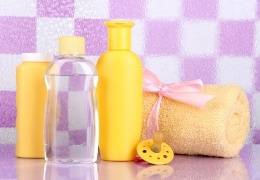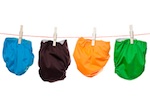This Baby article covers basic bathing and changing techniques that are tried and tested by midwives and mothers for bathing and changing your baby.
Bathing and changing that slippery, wriggly wee thing for the first time can actually be terrifying! The fear of dropping them, hurting them, distressing them… the dreaded fear of the uninitiated!
Well here are some great tips on how you can all survive bathing and changing time and come out of it relatively unscathed.
To get yourself prepared before baby comes along, read our article on Bathing & Changing Gear – this article outlines what equipment you will definitely need and what comes under the ‘nice to have’ category.
Now, let’s talk about technique….
Changing your Baby’s Nappy
There are some variations on this one, depending on whether you are using disposable nappies, flat cloth nappies or modern cloth nappies. Generally the aim is to remove the dirty nappy as swiftly as possible, clean the bottom and apply a new one before any accidents happen!
As with everything to do with babies, safety is paramount. I always changed all my kids’ nappies on the floor, using a big sturdy changing mat, so that I could turn my back without a danger of them falling off. As many a Plunket nurse has observed, “baby can’t fall off the floor”!
If you decide you would prefer to use a changing table, then get organised and be sure that everything is at hand before you start – and don’t turn your back for a minute. Nowadays, most change tables come fitted with a strap you can fasten across baby’s tummy as well as high rolled sides, to help prevent baby falling off.
What you will need for changing the baby’s nappy
- Wipes or cotton wool
- Water
- Bag or bucket for soiled nappy
- Clean clothes for baby (in case the nappy has leaked)
- A barrier cream if you need one
- And a clean nappy of course.
There are some times – when you’re on your way out or it’s the middle of the night – when it will be minimal fuss and interaction, you’re merely getting the job done.
Other times changing can be great fun, with lots of ‘peek a boo’ and raspberries on the tummy. Airing baby’s bottom is a great way to prevent nappy rash – simply pop an old towel under their bottoms and let them have a good play with a bare bottom. They love it! If you’re going to do this, make sure you have placed baby on the floor, not left them on the change table. And be aware – baby boys have an amazing ability to wee in a huge arc! Use a big, old towel!
Use the nappy itself to remove any excess poo from baby’s skin and then quickly fold the nappy and pop it away for disposal or cleaning, otherwise your baby’s foot will find it’s way straight into the middle of the dirty nappy!
Clean baby’s bottom from front to back to prevent spreading infection. The foreskin of wee boys is self cleaning so be gentle with it. You may notice a pink staining on the nappies of boys in the first few days, this is urate crystals and is entirely normal. If in doubt, show the nappy to your midwife. Once again, watch out for baby boys who can wee in a big arc and soak you when you’re standing at the end of the change table!
Little baby girls may also have a pseudo period due to the presence of mum’s hormones in their bodies during the first few days. Again, this is entirely normal, but if in doubt check it out with your midwife. Their labia are self cleaning also, but if you’ve had ‘the nappy to end all nappies’ open the labia carefully and clean gently, front to back.
There are a variety of barrier creams available – for more information visit Nappy Accessories – but the majority of babies will not need a cream applied to their skin. The best preventative measures for nappy rash are changing the nappies frequently and airing baby’s bottom daily. If baby’s bottom is red (this is common when they are teething) apply a thin layer of the barrier cream of your choice, checking regularly to see whether it is helping to heal the skin.
Baby powder is not necessary, babies smell quite delicious on their own. There is also a safety issue with powder as it could be inhaled by your baby, so if you do choose to use it, sprinkle it onto your hand first, not directly onto your baby.
Applying a clean nappy will depend upon which kind you are using – see our range of Nappies articles in this section. A flat cloth nappy will need to be folded and it’s wise to prepare a few in advance. If you’re using disposable or pre-shaped modern cloth nappies then there is simply a right way and a wrong way of putting them on. The end with the tabs goes under baby’s bottom, the other end is then brought forward between their legs so that the tabs can be brought over baby’s hips and secured onto the front of the nappy. Simple! You’ll only get it wrong once.
Things to look out for at changing time:
- Check the nappy is not fastened too tight – you should be able to slip a couple of fingers in the waist.
- Check that little willies are tucked downwards to prevent a soaked singlet.
- Check the legs are not too tight, but sufficiently snug to prevent a leakage.
Either dispose of your nappy, or put it to soak if it’s cloth. Cleaning any excess poo off in the toilet (shower attachments can be connected to help this) will save a lot of cleaning later.
Bathing your Baby
The majority of parents use bath time as part of the evening settling routine for babies and toddlers and it’s loads of fun. However, it can be a bit daunting at first and nothing quite replaces watching someone do it and then having a go yourself.
A few safety tips for bathing your baby to start with –
- Place the baby bath on the floor, or on a sturdy, flat surface – such as a kitchen bench, a custom made change table or inside your own bath
- Get all your bits and pieces ready before you start – never leave babies or toddlers unattended in water, even for a minute
- Check the temperature of the water first – a pleasant luke warm is ideal
- Shut the windows and doors to prevent baby getting cold and if it’s winter, warm your towel
So here we go…
- Remove baby’s clothes, but leave the nappy on for now
- Wrap baby in a towel, with face and head exposed
- Using a clean face cloth gently wipe baby’s face, avoiding the eyes (they don’t need cleaning unless baby has sticky eyes – and this should be done separately using cooled boiled water, cleaning from the centre of the eye outwards, using each cotton wool ball once only)
- Hold your baby under your arm like a rugby ball – now you’ve got a free hand – and hold baby over the bath
- Scoop water onto baby’s head and rub gently, using a mild shampoo, only if necessary
- Now dry baby’s face and hair and unwrap baby and remove the nappy
- If the nappy is soiled then clean baby’s bottom before bathing
- Otherwise hold your baby under the shoulders with one arm and get a firm grip of the little arm furthest away from you. Use the other hand to grasp the feet and now you’ve got a lovely secure hold to lift baby into the water.
- Keep holding onto baby – they really are slippery – with your arm under their shoulders and use your other hand to wash your baby down. If your baby is yelling in protest then keep it quick and scoop them out using the foot grasp again.
- Pop baby back onto that lovely warm towel and have a delicious cuddle with your gorgeous smelling baby!
- If the room is nice and warm, let baby have a kick around before you pop a nappy and clothes back on. I’d advise an old towel under their bottoms at this stage!!!
Dressing babies can be awkward if they’re crying and wriggling. Bear this in mind when you’re choosing clothes with loads of poppers. I loved the long nighties, which are so snug and so easy for those 3 o clock in the morning changes. If baby’s desperately hungry, pop a nappy on and give baby a quick feed wrapped in a dry towel and dress them later.
A Few Tips for Bathing & Changing your Baby
Baby’s nails
If your baby’s nails need cutting it is actually best to gently bite them or tear them, rather than cutting them. If baby wriggles while you’re cutting their nails, there is a risk that you could cut their skin too, which may result in an infection in the nail bed. If you prefer to cut them, use clippers rather than scissors, enlist the help of another pair of hands to hold baby still, or cut them while baby is sleeping.
Top & Tail
Babies do not need to be bathed every day – once or twice a week is enough – but a good ‘top and tail’ is necessary every day. This involves a good wash of baby’s face, neck and ears with a warm flannel (avoid the eyes unless they are sticky) and a thorough wash of baby’s bottom – using a separate cloth .
Sticky Eyes
Sticky eyes are common in babies. Usually this is due to blocked tear ducts, but occasionally it is due to an eye infection. If the eyelids and surrounding skin are red and angry, it is probably an infection and needs antibiotics which your GP can prescribe. If the skin looks healthy then it is probably a blocked tear duct; clean the eyes with cooled, boiled water and cotton wool, using a separate piece of cotton each time, starting from the centre of the eye and moving outwards. Also massaging down the side of the nose in downwards strokes, may help to unblock the tear duct.
Some useful Articles and resources for bathing and changing your baby
For information on what to look for when buying changing gear and baby baths see our article Bathing & Changing Gear.
There are a whole range of articles on Nappies to help you decide between reusable and disposable nappies as well as Nappy Accessories.





